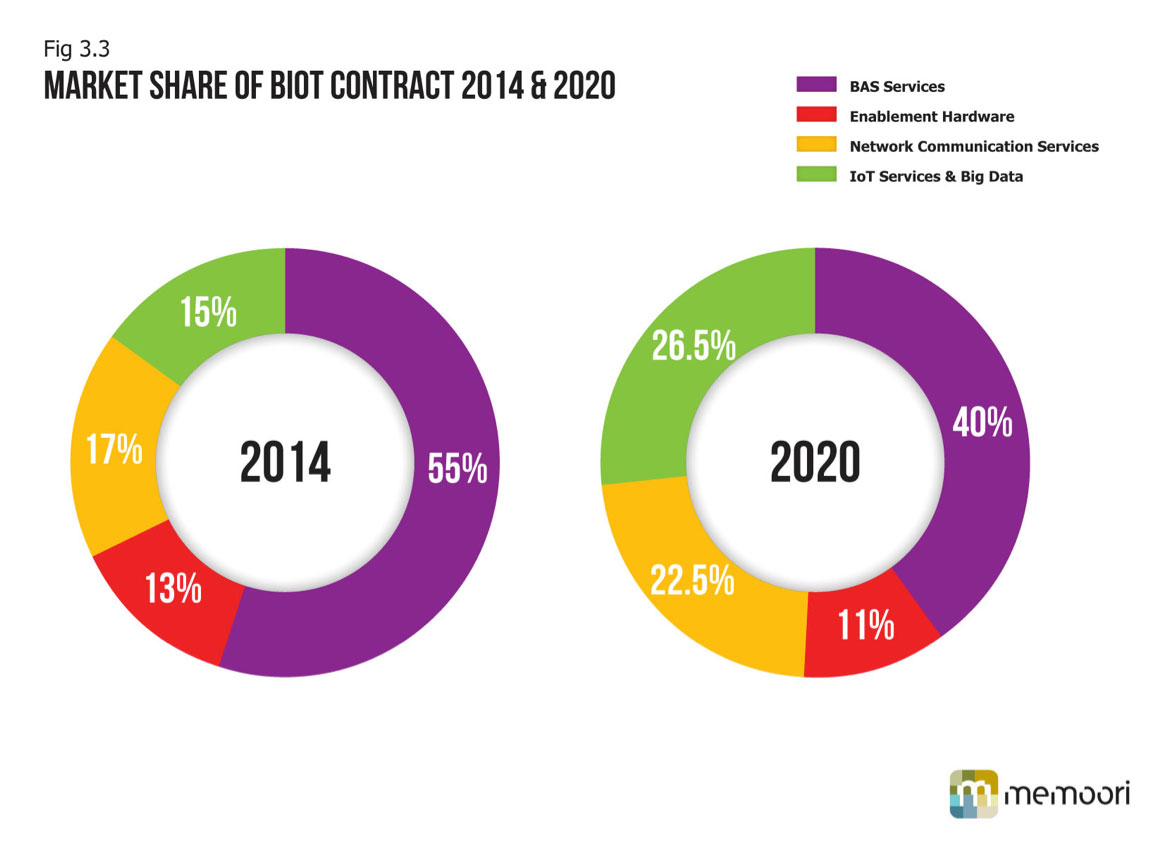Transition From BAS to BIoT Is Underway
Part 2 of a 2-part article about factors driving and limiting development of the Building Internet of Things (BIoT)
But while the full BIoT has arrived, apart from demonstration projects, it is today restricted to a few applications where the BAS is not too complex and the same “open communications protocol” is acceptable across all of the devices within each BAS service. However, connecting devices through IP networks has been taken up and is growing fast in virtually all the nine BAS services that we have analyzed in the report but sharing an open communication protocol for all the services is for the moment unlikely to be practical. For this reason, the full implementation of BIoT in commercial buildings is going to take until the end of the decade before it gains a substantial share of the available technical market potential, and cyber security issues are resolved.
The chart below shows the usage of IP connectivity for BAS services in commercial buildings in 2014 and forecast to 2020. Memoori forecasts that the market for BIoT including all the BAS services at installed prices was worth approximately $46 billion in 2014 and is forecast to grow to $155 billion in 2020. It should be understood that not all of this will be full blown BIoT covering all the BAS services in one system.

The ratcheting up process will start by taking the low-hanging fruit and in particular vertical markets and new construction projects where the ROI is best. Growth is likely to accelerate further in the following 5 years as Big Data and cloud services increase their share of the BIoT business. The value of the BAS hardware associated with BIoT projects in 2014 accounted for approximately 55 percent of the total, enablement hardware took a 13 percent share, network communication services 17 percent and IoT data services secured 15 percent. These numbers include IP connectivity across single and multiple BAS services, but we have yet to identify any complex building that uses one single platform to connect all BAS services, particularly where distributed power and demand response are part of the system. However, we have identified LED lighting control systems in new construction, prestige, medium-sized office buildings that have achieved a full BIoT system across lighting control, energy control, and access control. So full BioT has arrived, and the most successful strategy to move forward fast is to identify where the current technical obstacles have least impact and the benefits are most likely to be realized. New construction projects and retail buildings fall into this category.
At this time most of the initiative and investment in BIoT development is being made by the IoT contingent, including the chip manufacturers and IT communications companies, and if this continues they will become the dominant force in this business. They hold all the new technology to deliver the IoT for a fully automated building. They have invested billions of U.S. dollars in developing products and services; however, they know little about the design, installation, operation, and servicing of buildings, which is still within the purview of the manufacturers of BAS systems. In addition, these companies have direct access to a vast legacy real estate that will need to be retrofitted.
These two camps need to be brought together to combine their expertise if the full benefits of BIoT are to be realized and meet the customer’s buying proposition.
During the last three years the major companies in each camp have been working together and more recently have formed strategic alliances to develop both products and markets. An even more positive measure of the need to share skills and expertise has been the rise in acquisition activity across these two technologies.
Building owners can expect more IT professionals knocking at their doors to extoll the virtues of BIoT.
This review is taken from memoori’s report: “The Transformation of BAS to BIoT 2015 – 2020.”
Allan McHale is a chartered mechanical and energy engineer having spent some 40 years in the energy industry. His experience covers both design installation and techno commercial posts for manufacturing and business consultancy companies across the world. He is currently a director of memoori ltd a web based information company focused on Smart Buildings. He can be reached at allan@memoori.com.
Related Topics:










